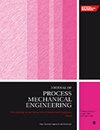基于神经网络的 PET-G FFF 工艺建模:评估 MLPNN 和 RBFNN 在机械性能预测中的性能
IF 2.2
4区 工程技术
Q2 ENGINEERING, MECHANICAL
Proceedings of the Institution of Mechanical Engineers, Part E: Journal of Process Mechanical Engineering
Pub Date : 2024-08-23
DOI:10.1177/09544089241272752
引用次数: 0
摘要
PET-G 是一种多功能热塑性塑料,具有抗冲击负荷、耐热和耐溶剂反应的特性,在显示和标识、包装、汽车、电子和医疗行业得到广泛应用。由于相关的初始设置成本较高,使用传统技术定制生产成本较高,在这种情况下,3D 打印可能是更好的选择,但预测其在 3D 打印过程中的行为仍具有挑战性。因此,目前的研究旨在寻找有效的过程建模技术,以实现理想的响应。研究人员对 MLPNN 和 RBFNN 等建模技术进行了比较,以预测 FFF 选定工艺参数下的机械性能,从而显著提高机械性能预测结果。具有 5 个输入维度和 20 个隐藏单元的 MLP 的 CF 值为 0.99918,特异性为 1。其 MSE 为 2.0751。另一方面,具有 5 个输入维度和 20 个中心的 RBF 网络的 MSE 低得多,为 0.004589,但 CF 值略低(0.92188 和 0.93393)。这些发现凸显了 MLP 在精度方面的优势,而 RBF 则证明了模型在预测机械性能方面的准确性。本文章由计算机程序翻译,如有差异,请以英文原文为准。
Neural network-based modeling of FFF process for PET-G: Evaluating MLPNN and RBFNN performance in mechanical property prediction
PET-G is a versatile thermoplastic resistant to impact loading, heat, and reactivity with solvents, and witnesses wide use in the Display and Signage, Packaging, Automotive, Electronics, and Medical Industries. Customized production using conventional techniques is expensive due to the high initial setup costs associated, in such cases 3D printing may be a better choice, but predicting its behavior during 3D printing remains challenging. Therefore, the current study aims to find effective process modeling techniques to achieve desired responses. The comparison of modeling techniques like MLPNN and RBFNN has been carried out to predict the mechanical properties at selected process parameters of FFF to significantly improve the mechanical property predictions. The MLP, which had 5 input dimensions and 20 hidden units, showed a CF of 0.99918 and specificity 1. Its MSE was 2.0751. On the other hand, the RBF network, with 5 input dimensions and 20 centers had a considerably lower MSE of 0.004589 but slightly lower CF values (0.92188 and 0.93393). These findings highlight that MLP excels in precision while RBF demonstrates the accuracy of the models for predicting mechanical properties.
求助全文
通过发布文献求助,成功后即可免费获取论文全文。
去求助
来源期刊
CiteScore
3.80
自引率
16.70%
发文量
370
审稿时长
6 months
期刊介绍:
The Journal of Process Mechanical Engineering publishes high-quality, peer-reviewed papers covering a broad area of mechanical engineering activities associated with the design and operation of process equipment.

 求助内容:
求助内容: 应助结果提醒方式:
应助结果提醒方式:


